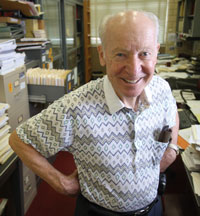Stan Trout, Spontaneous Materials
It was nice to see so many people at Magnetics 2018 in Orlando last month. It was a very pleasant exchange of ideas and information. We all seemed to get plenty of exercise, walking through the Hyatt Regency to our meeting rooms.
I had the good fortune on the first day to be part of the Keynote Panel Discussion called The Future of the Magnetics Industry Pricing, Trends, Technology. I thought I would use this opportunity to share some of the answers I provided to questions posed to the panel.
Topic One: Will there ever be a time when the market for REs used in magnets will not be considered volatile? Or will there ever be a surplus of rare earths used in magnets? Or is there a surplus now and the narrative is implying that there is a shortage or critical supply?
Let me answers this set of questions, beginning with the last question and using the graphics depicting rare earths below to explain.


Except for samarium, currently there is no surplus of the rare earths used in magnets! We have the distinction of using the few elements which govern the production rates for all rare earth mining and processing, mainly neodymium and dysprosium. This is the root cause of the market conditions we see.
Today many of us use a mixture of neodymium and praseodymium, instead of neodymium alone in our NdFeB magnets. This is done solely to extend the availability of neodymium, not for any magnetic reason. No sane rare earth producer would ever include Pr with neodymium, unless there is a serious shortage of Nd and a surplus of Pr. When we see Pr going into other applications, we will know the rare earth market is shifting.
It is possible that the rare earths used in magnets could go back into surplus and become less volatile, as they once were, if the demand for both cerium and lanthanum were to increase and/or the demand for neodymium were to fall off. I believe the solution is not to develop more mines or find more deposits, but to establish more balanced demand for all rare earths, especially cerium and lanthanum. Make no mistake, the challenge to find new large-scale applications for cerium and lanthanum is not trivial. In order to significantly affect the rare earth market, a few new applications for cerium and lanthanum which are roughly the same size as the current NdFeB market would need to be commercialized, due to the natural abundance of these elements in the ore. There are a few prospective technologies that in combination might do the trick, but they need to get out of the lab and cross the valley of death to be commercialized. There is still much work to do.
Topic Two: We talk about raw material resources as an issue, but what about the human factor, such as the technology knowhow, magnetic and application engineers/specialists? Where will these people come from?
I have heard this question in various forms over the years and have always puzzled over the premise contained within this question. Perhaps that is because I am a supplier of technical expertise and the person asking the question is usually a consumer of technical expertise. This difference in perspective makes for an interesting discussion. Ill put forward my thoughts from the supply side and leave it to someone else to state the other point of view.
If you look around at the technical people working in the US magnet industry, you find that they fall into two broad camps. A few, like me, were actually formally educated in the discipline they are practicing. But far more common are technical people who started with a good general background in science or engineering and learned their craft on the job. Some of these folks even took one or more of my bootcamps to get themselves up to speed.
On-job-training is a longstanding approach, that seems to be working well enough in our industry. There is no shortage of graduates with technical degrees. The only downside is finding good people and the delay in getting a new person up to speed. But there are ways to shorten this time, which turns out to be a significant part of my business.
The other way to look at this question is from the point of view of the universities. Today there are about a dozen institutions in the US with a professor or two doing something related to permanent magnets or magnetic materials more generally. These programs are turning out graduates at a small but steady rate. If you look at where these graduates go, they rarely enter the US permanent magnet industry. It is more common for them to remain academics, to work at a research lab, or even to take jobs in Chinas magnet factories.
Universities are simply a minor player in staffing the US permanent magnet industry; the well-established path is on-job-training.
About the Author
Dr. Stan Trout has more than 35 years experience in the permanent magnet and rare earth industries. Dr. Trout has a B.S. in Physics from Lafayette College and a Ph.D. in Metallurgy and Materials Science from the University of Pennsylvania. Stan is a contributing columnist for Magnetics Business & Technology magazine. Spontaneous Materials, his consultancy, provides practical solutions in magnetic materials, the rare earths, technical training and technical writing. He can be reached at strout@ieee.org.



